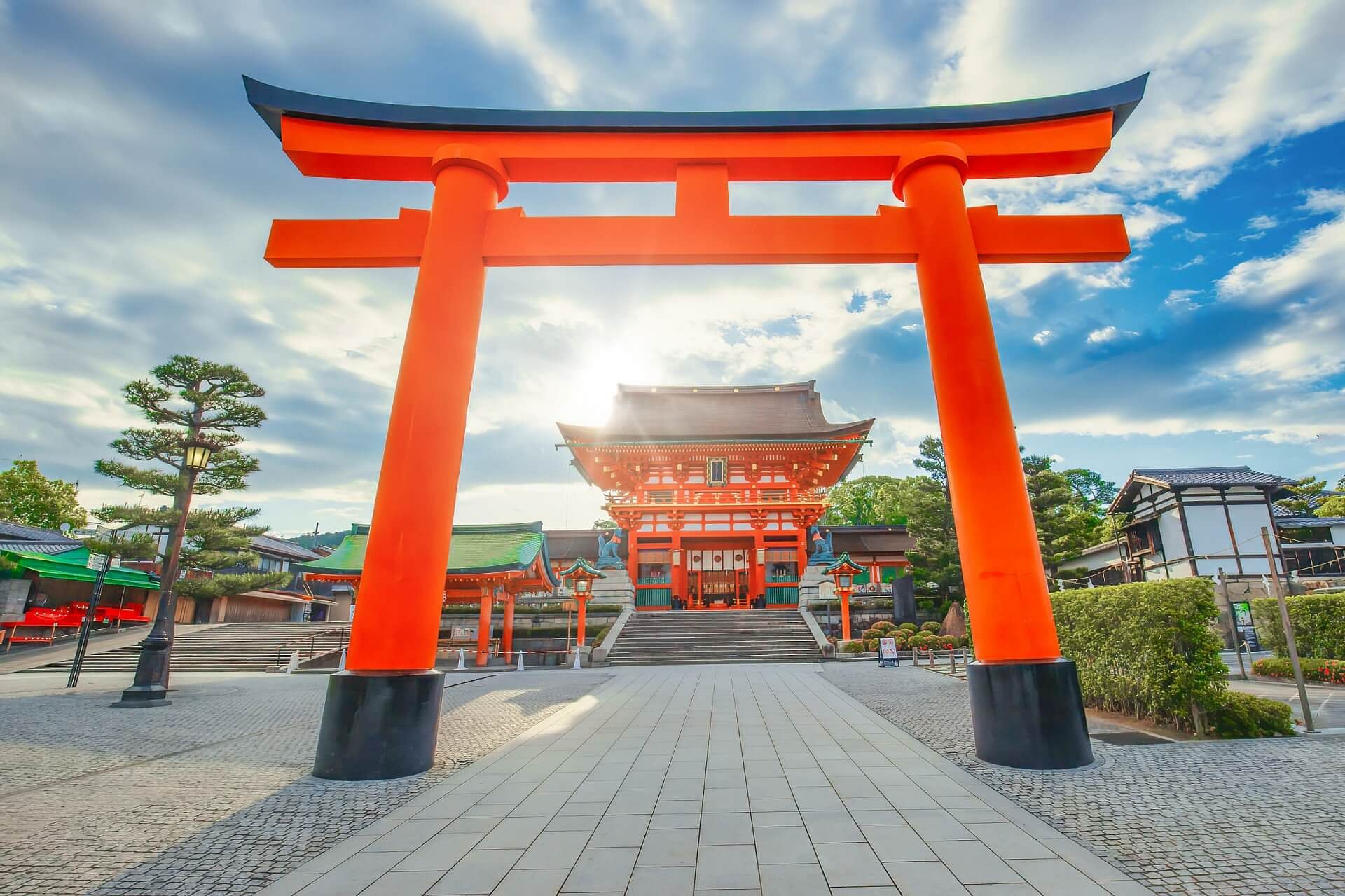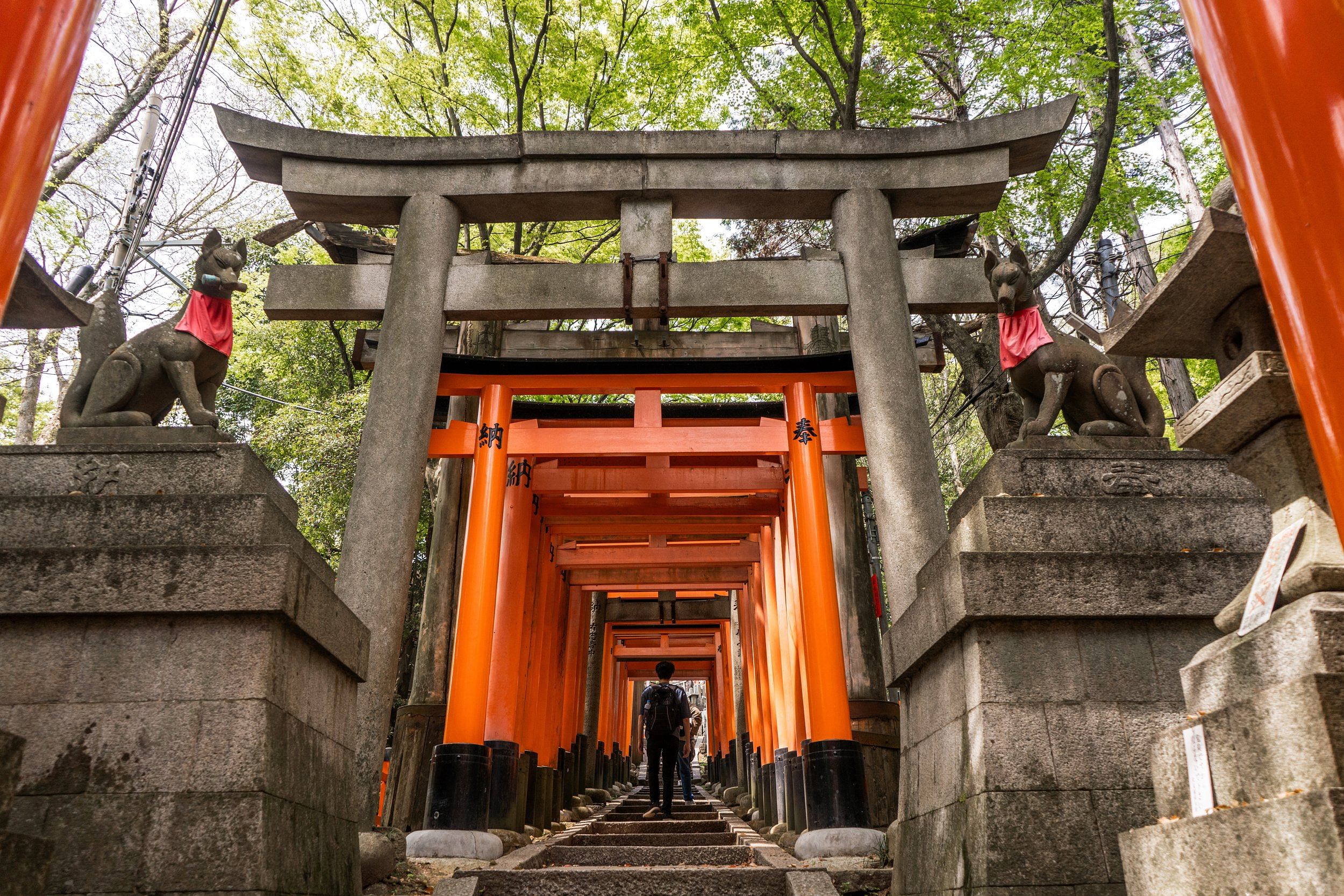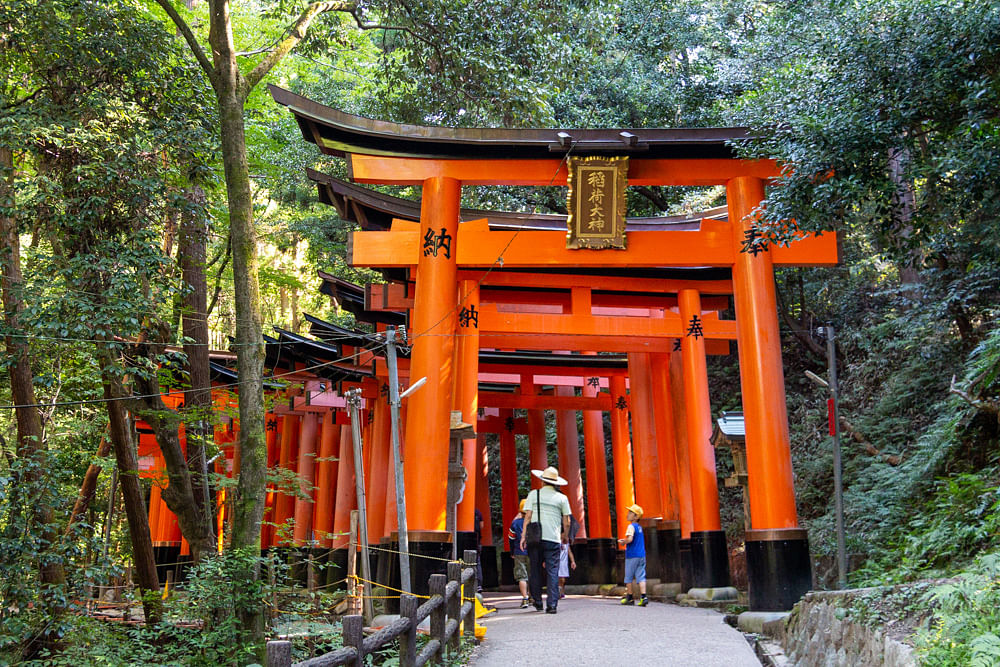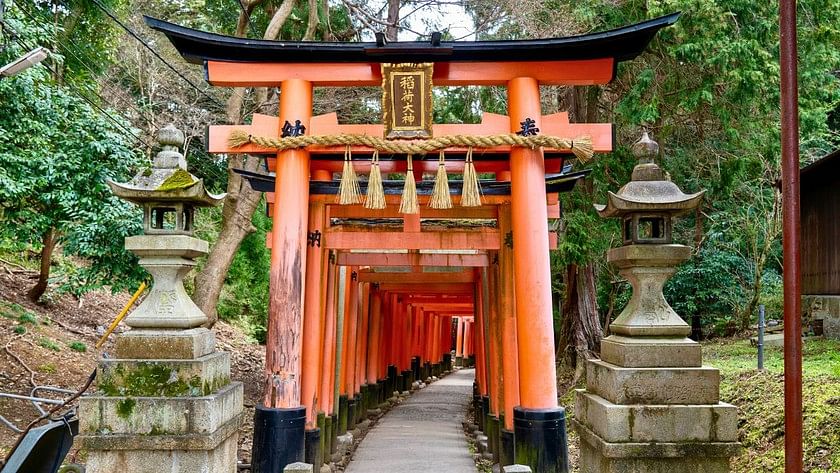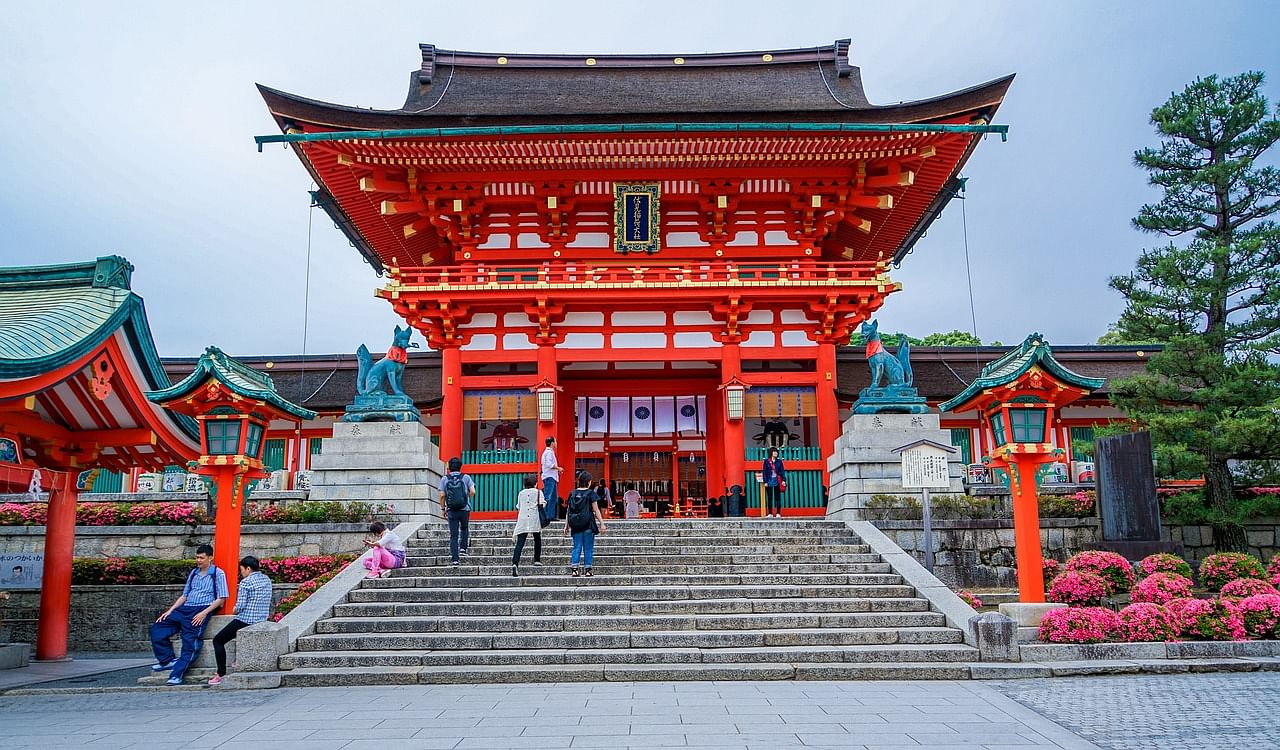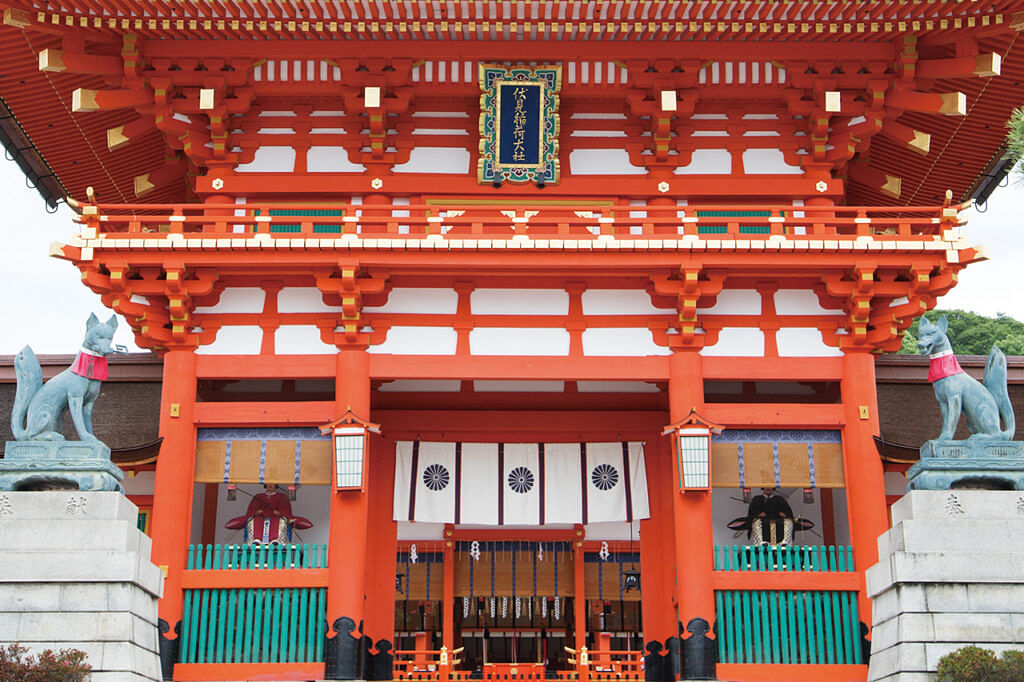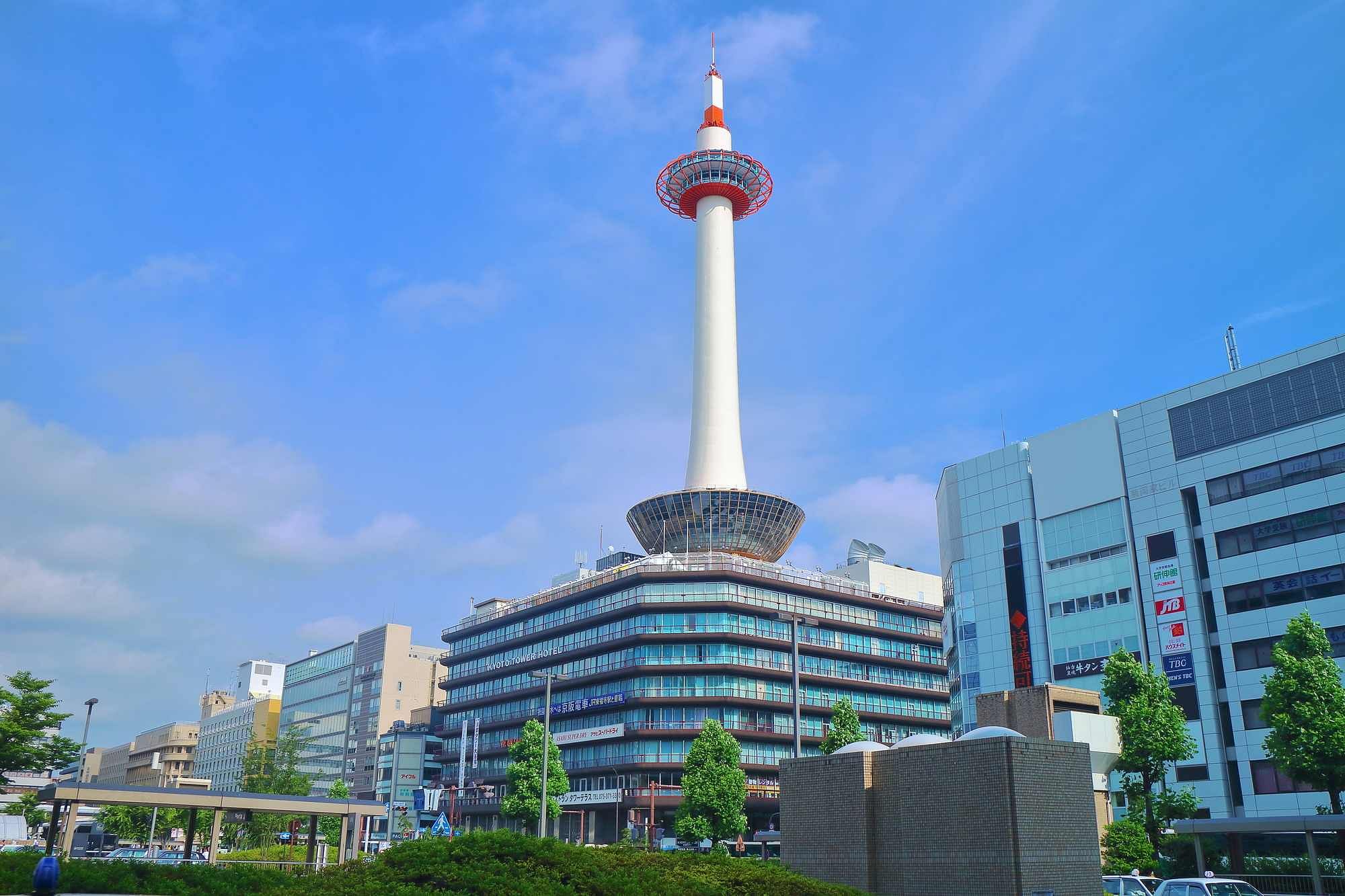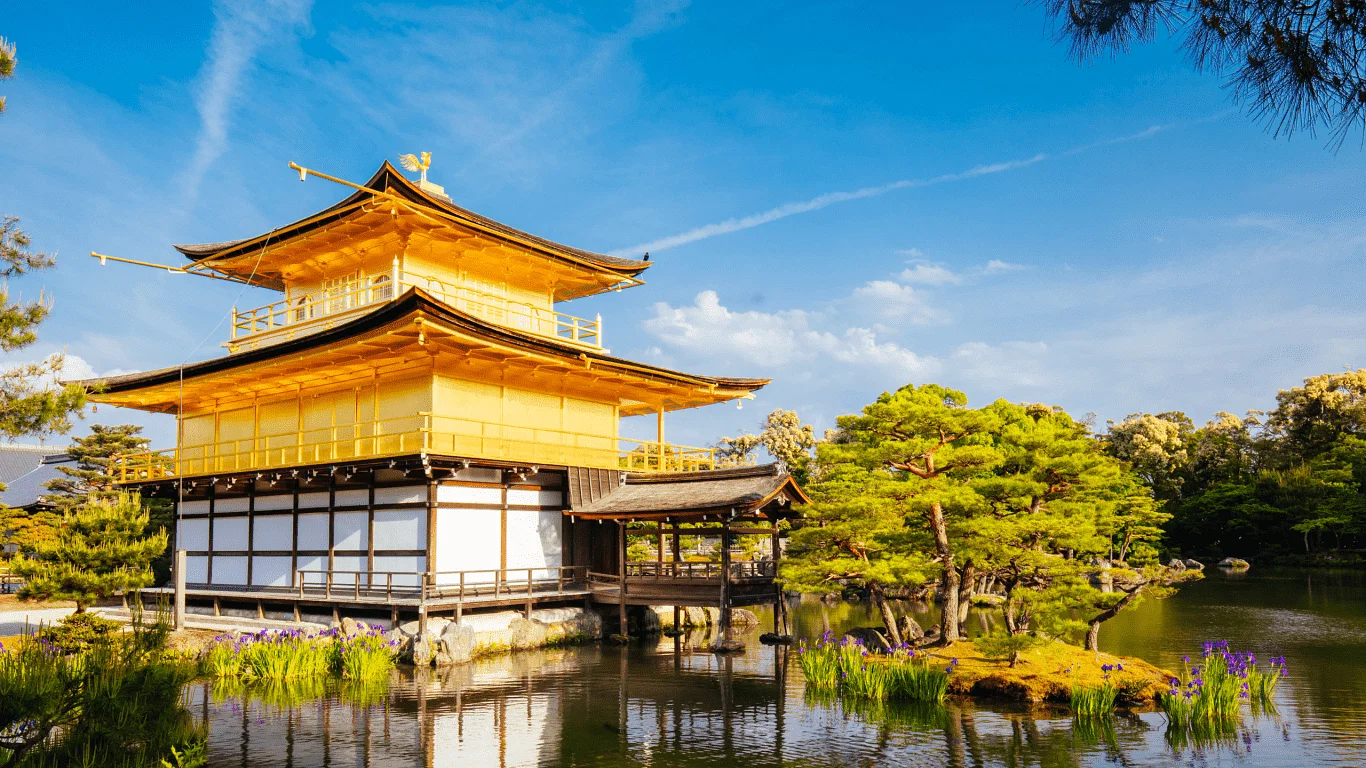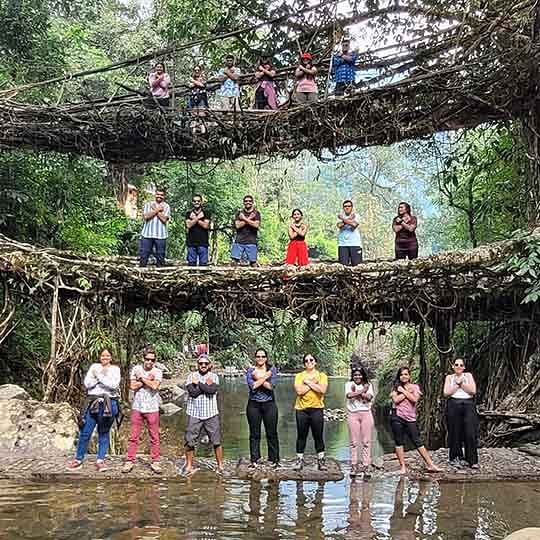Have you ever wondered what it’s like to walk through a tunnel of endless orange gates while stone foxes watch your every move? Picture this: a mountain draped in a thousand orange gates that look like they’ve tumbled straight out of a Studio Ghibli film. That’s Fushimi Inari Taisha for you – possibly the most Instagram-famous shrine in all of Kyoto. It is just a small part of the incredible Places to Visit in Japan.Fushimi Inari Taisha Kyoto dates back to 711, (yes, older than your local convenience store). However, it is much more than the standard check on the list of places to visit in Kyoto. It is a series of torii gates as far as the eyes can see, and they seem to surround the pyramid-like structure. Not to mention sputtering stone foxes, some of whom might just smile at you.
When you’re planning your things to do in Kyoto, here’s a pro tip: sneak in at dawn. While everyone else is still hitting snooze, you’ll have the gates almost to yourself. Want to make it even better?
Check out our Japan tour packages that include early morning visits. Sunrise is also quite amazing for these gates, as the sun’s rays make everything appear golden, and the only sound is soft footsteps and the cries of stray cats. Do carry some additional energy with you because even though fox-shaped cookies are delightful, the trip to the Fushimi Inari Taisha Shrine is long and would make one quite hungry.
Fushimi Inari Taisha: A Magical Shrine in Kyoto
Fushimi Inari Taisha is one of the most famous places in Kyoto, Japan. Known for its thousands of bright red gates called torii, this shrine is a must-visit for anyone traveling to Japan. It is a place full of beauty, history, and culture, making it one of the top attractions in Kyoto. Exploring this shrine is one of the best things to do in Japan. What is Fushimi Inari Taisha Kyoto?
Fushimi Inari Taisha Kyoto is a Shinto shrine dedicated to Inari, the god of rice, prosperity, and success. It is over 1,300 years old, making it one of the oldest shrines in Japan. Visitors love its peaceful vibe and unique features. The highlight of the shrine is the thousands of torii gates that create paths up and around Mount Inari. Walking through these gates feels like stepping into another world.This shrine in Kyoto is open 24/7, and you can visit it anytime. Whether you come in the early morning or evening, the experience is always magical.
Suggested Read: Omoide Yokocho
Fushimi Inari Shrine Entrance Fee
One of the best things about visiting Fushimi Inari Taisha is that there is no charge to enter the shrine. Yes, the Fushimi Inari Shrine entrance fee is completely free! This makes it a perfect destination for travelers who want to experience the beauty and culture of Kyoto without worrying about extra costs.Visitors can explore the entire shrine complex, including the famous torii gate paths, without paying any Fushimi Inari Shrine entrance fee. Whether you’re walking through the thousands of red gates, stopping to pray at one of the smaller shrines, or hiking up Mount Inari, the experience is accessible to everyone.
Even though the Fushimi Inari Shrine entrance fee is free, you can support the shrine by making small donations. Many visitors choose to buy charms, write their wishes on wooden ema plaques, or offer coins at the main shrine to show their gratitude. These contributions help maintain the shrine and its traditions.
The fact that there is no Fushimi Inari Shrine entrance fee makes this incredible shrine not only spiritually enriching but also budget-friendly. Whether you’re traveling solo, with family, or in a group, this iconic spot is a must-visit without any financial burden!
Suggested Read: Tsukiji Outer Market
Best Time to Visit Fushimi Inari Taisha
The best time to visit Fushimi Inari Taisha depends on the kind of experience you are looking for. This iconic shrine is open 24 hours a day, so you can visit early in the morning, during the day, or even at night. Each time of day offers something unique!1. Morning Visit: The best time to visit Fushimi Inari Taisha for a peaceful and quiet experience is early in the morning, around sunrise. At this time, there are fewer tourists, and you can enjoy the serenity of the shrine. Walking through the famous torii gates without crowds makes it easier to take stunning photos and soak in the spiritual atmosphere.
2. Daytime Visit: If you prefer to explore in daylight and want to capture the vibrant red color of the torii gates, daytime is ideal. The shrine becomes livelier with more visitors, and you can easily explore the shopping in Japan and food stalls around the area. Spring and autumn are particularly popular, as the cherry blossoms or colorful leaves add to the beauty of the shrine.
3. Evening Visit: For a special experience, the best time to visit Fushimi Inari Taisha could be late in the evening or just before sunset. The soft lighting creates a magical atmosphere, and as night falls, the paths are illuminated with lanterns, making the hike up Mount Inari enchanting. Plus, there are fewer visitors in the evening.
4. Seasonal Visits: Another factor to consider is the season. The best time to visit Fushimi Inari Taisha during spring is when the cherry blossoms bloom, making the shrine and its surroundings beautiful. Autumn, with its vibrant red and orange leaves, also offers a stunning backdrop. In summer, the greenery creates a refreshing vibe, while winter has its beauty with fewer crowds and a peaceful setting.
No matter when you go, the shrine’s beauty and spiritual energy make it worth visiting. Planning your trip during the best time to visit Fushimi Inari Taisha ensures you have an unforgettable experience.
Suggested Read: Ginza, Tokyo
What to See and Do at Fushimi Inari Taisha
Fushimi Inari Taisha has so much to offer that you can easily spend several hours here. Here’s a detailed look at what you can see and do:1. Romon Gate: This grand gate is the first thing you’ll notice when you enter. It’s a striking structure donated by the famous samurai Toyotomi Hideyoshi in 1589. It serves as a beautiful welcome to the shrine.
2. Main Shrine (Honden): This is the central part of Fushimi Inari Taisha. Here, visitors come to pray for success, health, and prosperity. The area around the main shrine is peaceful, making it a great spot to take in the spiritual atmosphere.
3. Senbon Torii (Thousand Torii Gates): The most iconic feature of the shrine is the thousands of red torii gates. These gates create beautiful paths that lead up Mount Inari. Each gate is donated by individuals or businesses as a token of gratitude. Walking through the gates is an amazing experience and one of the top highlights of Fushimi Inari Taisha Kyoto.
4. Yotsutsuji Intersection: This is a rest area about halfway up the mountain. From here, you can enjoy stunning views of Kyoto city. It’s an excellent spot to relax and take photos.
5. Fox Statues (Kitsune): Throughout the shrine, you’ll notice fox statues. In Japanese culture, foxes are considered messengers of the god Inari. Some statues hold a key in their mouths, symbolizing the key to a rice granary. These statues add a unique touch to the shrine.
6. Omokaru Stones: Near the main shrine, you’ll find these stones. Visitors make a wish and try to lift a stone. If it feels lighter than expected, it is believed that your wish will come true.
7. Hiking Trails: Beyond the gates, hiking trails go up Mount Inari. These trails are surrounded by nature and lead to smaller shrines along the way. Hiking here is a wonderful way to connect with nature while exploring the spiritual side of Kyoto.
8. Ema Boards and Fortune Slips: Visitors can purchase wooden boards called “Ema” to write their wishes and hang them at the shrine. You can also try your luck with fortune slips to see what the future holds.
Suggested Read: Shopping in Tokyo
Places Near Fushimi Inari Taisha
There are several interesting places near Fushimi Inari Taisha to explore: Here are some simple ideas:1. Tofukuji Temple: Just a short walk away, this temple is famous for its peaceful gardens and beautiful maple trees, especially in autumn. You can walk across a wooden bridge and enjoy the view of the trees below.
2. Sake Breweries in Fushimi: Fushimi is well-known for its sake (Japanese rice wine). You can visit breweries to learn how sake is made and even taste some. It’s a fun way to experience Japanese culture.
3. Gekkeikan Okura Sake Museum: This museum is perfect if you want to know more about sake. You’ll see old tools used for brewing, learn about its history, and even get to taste some. It’s both educational and enjoyable.
4. Mount Inari: If you enjoy hiking, you can continue up the trails at Fushimi Inari Taisha to the top of Mount Inari. Along the way, you’ll see small shrines and get great views of Kyoto. It’s a peaceful and rewarding walk.
5. Kyoto Tower: A little farther away, Kyoto Tower offers amazing views of the city. It’s a great place to visit after exploring Fushimi Inari Taisha and is easy to reach by train.
6. Fushimi Castle (Momoyama Castle): This castle is just a short trip from the shrine. It’s a beautiful place for photos, and the surrounding park is perfect for a relaxing walk. It is one of the best places near Fushimi Inari Taisha Tokyo.
These places near Fushimi Inari Taisha are easy to visit and allow you to enjoy more of Kyoto’s history, nature, and culture. You might also like to visit Universal Studio Japan, which is just an hour’s train ride away from Kyoto. They’re great additions to your Kyoto sightseeing plan!
Suggested Read: Akihabara Electric Town
Shrine in Kyoto: Cultural Significance
As a shrine in Kyoto, Fushimi Inari Taisha has deep cultural meaning. People come here to pray for prosperity, success, and good health. It is also known for its fox statues called “Kitsune,” which are believed to be the messengers of Inari. The foxes often hold a key in their mouths, symbolizing the key to rice storage. This adds a unique touch to the shrine’s spiritual importance.If you’re visiting Kyoto, add other top attractions in Kyoto to your list along with Fushimi Inari Taisha. Here are some must-visit places:1. Kinkaku-ji (Golden Pavilion)
Kinkaku-ji is one of the most photographed landmarks in Japan and a must-see when exploring Kyoto sightseeing spots. The shimmering golden temple surrounded by ponds and gardens is stunning in every season, whether framed by cherry blossoms, greenery, or snow.
2. Arashiyama Bamboo Grove
Walking through the towering bamboo stalks of Arashiyama is like stepping into another world. This peaceful and enchanting grove is another of the top attractions in Kyoto and is perfect for photography. The nearby Togetsukyo Bridge and Monkey Park add even more beauty to the area.
3. Gion District
Known for its traditional wooden machiya houses, Gion is the heart of Kyoto’s geisha culture. Walking through this historic area is one of the highlights of Kyoto sightseeing. You might even spot a geisha or maiko (apprentice geisha) walking to an appointment in the evening.
4. Kiyomizu-Dera Temple
This UNESCO World Heritage Site is perched on a hillside and offers stunning views of Kyoto. The temple’s wooden stage is especially popular during cherry blossom season and autumn foliage. It’s a must-visit among the top attractions in Kyoto.
5. Nijo Castle
For history lovers, Nijo Castle provides a glimpse into the life of shoguns during the Edo period. The castle is famous for its “nightingale floors,” which chirp like birds when walked on, serving as a security measure. The gardens here are also beautiful, especially during spring and autumn.
Suggested Read: Rainbow Bridge Tokyo
6. Philosopher’s Path
This scenic walkway along a canal is lined with cherry trees, making it one of the most beautiful Kyoto sightseeing spots. It’s named after a famous philosopher who used to walk here while meditating.
7. Nishiki Market
Food lovers will enjoy exploring Nishiki Market, a busy street filled with shops selling traditional Kyoto dishes, snacks, and souvenirs. It’s a great place to taste local delicacies and learn about Kyoto’s culinary heritage.
8. Ryoan-ji Temple
Famous for its Zen rock garden, Ryoan-ji Temple is a serene and contemplative place to visit. The simple yet profound design of the garden makes it a favorite among the top attractions in Kyoto.
9. To-ji Temple
This temple is home to a five-story pagoda, the tallest wooden tower in Japan. It’s a symbol of Kyoto and a significant spot for Kyoto sightseeing, especially during special light-up events in spring and autumn.
10. Heian Shrine and Garden
Known for its massive torii gate and beautiful gardens, Heian Shrine is a peaceful retreat in the heart of Kyoto. The gardens are particularly lovely during cherry blossom season.
11. Kyoto Imperial Palace
The former residence of the Japanese Imperial family, this palace is surrounded by a beautiful park and offers guided tours to learn about Japan’s royal history.
Exploring these top attractions in Kyoto gives you a deep appreciation for the city’s blend of history, spirituality, and natural beauty. Combining these places with Fushimi Inari Taisha Kyoto gives you a well-rounded experience of the city’s beauty and culture.
Suggested Read: Shinjuku Gyoen National Garden
Kyoto Sightseeing Tips
Here are some tips to make your Kyoto sightseeing enjoyable:
- Start Early: Beat the crowds by visiting Fushimi Inari Taisha early in the morning.
- Wear Comfortable Shoes: There’s a lot of walking, especially if you plan to hike up Mount Inari.
- Bring Water: Stay hydrated, as the hike can be tiring.
- Respect Traditions: Be mindful of the shrine’s spiritual nature and avoid loud or disruptive behavior.
Fushimi Inari Taisha is more than just a beautiful place; it’s a journey into Japan’s culture, history, and spirituality. With no Fushimi Inari shrine entrance fee, it’s an accessible and unforgettable experience for all. Whether you come for the famous Torii gates, the peaceful atmosphere, or the hiking trails, this shrine in Kyoto will leave you with lasting memories. Add it to your list of top attractions in Kyoto and enjoy exploring the nearby spots to make your trip truly special. Whether it’s your first visit or one of many, Fushimi Inari Taisha Kyoto always feels magical.




